Effect size of memory deficits in mice with adult-onset P301L tau expression
- PMID: 25004446
- PMCID: PMC4151262
- DOI: 10.1016/j.bbr.2014.06.057
Effect size of memory deficits in mice with adult-onset P301L tau expression
Abstract
Transgenic mice expressing mutations in tau have yielded essential discoveries for Alzheimer's disease. One of the most commonly used tau mouse models is the tet-off Tg(tauP301L)4510 model that expresses P301L human tau driven by the calcium-calmodulin kinase IIα (CaMKIIα) promoter system. Tau expression in this model is regulatable, allowing for suppression of mutant tau expression until adulthood and prevention of possible developmental alterations resulting from P301L tau expression during development. Here, we compared the effect and sample sizes needed for three learning and memory tasks in mice with adult-onset P301L tau expression. Our findings indicate that the Incremental Repeated Acquisition (IRA) and trace fear conditioning tasks, neither of which have previously been published with these mice, were highly sensitive to P301L tau expression, whereas the Morris water maze, the most commonly used task with this model, was the least sensitive. Memory deficits were observed at a time when tau pathology was subtle and prior to readily detectable neuronal loss. Thus, we provide essential information (effect and sample sizes needed) for establishing experimental designs at a time point when memory deficits are likely to go undetected if inadequate sample sizes are used. Our work also suggests the tet-off Tg4510 model provides a way to avoid mutant tau expression during the perinatal and early postnatal stages, thereby preventing possible developmental alterations unrelated to Alzheimer's disease.
Keywords: Alzheimer's disease; Fear conditioning; Incremental repeated acquisition; Memory; Tau; Tg4510.
Copyright © 2014 Elsevier B.V. All rights reserved.
Figures
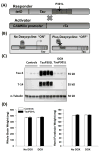
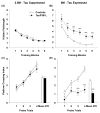
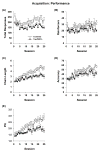
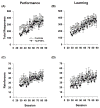
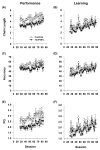
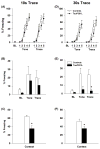

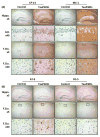

Similar articles
-
Dietary Lycopene Supplementation Improves Cognitive Performances in Tau Transgenic Mice Expressing P301L Mutation via Inhibiting Oxidative Stress and Tau Hyperphosphorylation.J Alzheimers Dis. 2017;57(2):475-482. doi: 10.3233/JAD-161216. J Alzheimers Dis. 2017. PMID: 28269786
-
A novel transgenic mouse expressing double mutant tau driven by its natural promoter exhibits tauopathy characteristics.Exp Neurol. 2008 Jul;212(1):71-84. doi: 10.1016/j.expneurol.2008.03.007. Epub 2008 Mar 21. Exp Neurol. 2008. PMID: 18490011
-
Improved long-term potentiation and memory in young tau-P301L transgenic mice before onset of hyperphosphorylation and tauopathy.J Neurosci. 2006 Mar 29;26(13):3514-23. doi: 10.1523/JNEUROSCI.5425-05.2006. J Neurosci. 2006. PMID: 16571759 Free PMC article.
-
Age-dependent neurofibrillary tangle formation, neuron loss, and memory impairment in a mouse model of human tauopathy (P301L).J Neurosci. 2005 Nov 16;25(46):10637-47. doi: 10.1523/JNEUROSCI.3279-05.2005. J Neurosci. 2005. PMID: 16291936 Free PMC article.
-
Zinc Exacerbates Tau Pathology in a Tau Mouse Model.J Alzheimers Dis. 2018;64(2):617-630. doi: 10.3233/JAD-180151. J Alzheimers Dis. 2018. PMID: 29914030
Cited by
-
Caspase-2 cleavage of tau reversibly impairs memory.Nat Med. 2016 Nov;22(11):1268-1276. doi: 10.1038/nm.4199. Epub 2016 Oct 10. Nat Med. 2016. PMID: 27723722
-
Riluzole rescues glutamate alterations, cognitive deficits, and tau pathology associated with P301L tau expression.J Neurochem. 2015 Oct;135(2):381-94. doi: 10.1111/jnc.13230. Epub 2015 Aug 13. J Neurochem. 2015. PMID: 26146790 Free PMC article.
-
Altered Synapse Stability in the Early Stages of Tauopathy.Cell Rep. 2017 Mar 28;18(13):3063-3068. doi: 10.1016/j.celrep.2017.03.013. Cell Rep. 2017. PMID: 28355559 Free PMC article.
-
Role of Kalirin and mouse strain in retention of spatial memory training in an Alzheimer's disease model mouse line.Neurobiol Aging. 2020 Nov;95:69-80. doi: 10.1016/j.neurobiolaging.2020.07.006. Epub 2020 Jul 14. Neurobiol Aging. 2020. PMID: 32768866 Free PMC article.
-
Riluzole rescues alterations in rapid glutamate transients in the hippocampus of rTg4510 mice.Metab Brain Dis. 2016 Jun;31(3):711-5. doi: 10.1007/s11011-015-9783-9. Epub 2016 Jan 8. Metab Brain Dis. 2016. PMID: 26744018 Free PMC article.
References
-
- Iqbal K, del C, Alonso A, Chen S, Chohan MO, El-Akkad E, Gong C-X, et al. Tau pathology in Alzheimer disease and other tauopathies. Biochimica et Biophysica Acta (BBA) - Molecular Basis of Disease. 2005;1739:198–210. - PubMed
-
- Caouette D, Xie Z, Milici A, Kuhn M, Bocan T, Yang D. Perinatal Suppression of Tau P301L Has a Long Lasting Preventive Effect against Neurodegeneration. International Journal of Neuropathology. 2013;1:53–69.
Publication types
MeSH terms
Substances
Grants and funding
LinkOut - more resources
Full Text Sources
Other Literature Sources
Medical
Miscellaneous

